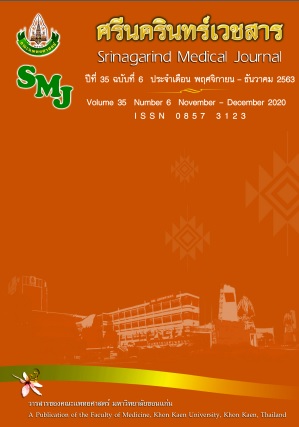Continuous Quality Improvement of Clinical Practice Guideline for Management of Patients Undergoing Percutaneous Nephrolithotomy Under General Anesthesia in Srinagarind Hospital
Abstract
การปรับปรุงคุณภาพอย่างต่อเนื่องของแนวทางปฏิบัติทางคลินิกสำหรับการดูแลผู้ป่วยที่ได้รับยาระงับความรู้สึกเพื่อผ่าตัดแบบเจาะผ่านผิวหนังเพื่อนำนิ่วออกจากไตในโรงพยาบาลศรีนครินทร์
วิลาวัลย์ สมดี1*, สิริรัตน์ ตรีพุทธรัตน์ 1, เทพกร สาธิตการมณี1, วิเชียร ศิริธนะพล2, นรินทร์ พลายละหาร1, ปกรณ์ เกียรติโศภิษฐ์ 2 , อุกฤษฎ ร่มไทรทอง2, สุธันนี สิมะจารึก1, วิริยา ถิ่นชีลอง1, กชกร พลาชีวะ1
1ภาควิชาวิสัญญีวิทยา คณะแพทยศาสตร์ มหาวิทยาลัยขอนแก่น , 40002
2ภาควิชาศัลยศาสตร์ คณะแพทยศาสตร์ มหาวิทยาลัยขอนแก่น, 40002
หลักการและวัตถุประสงค์: การผ่าตัดแบบเจาะผ่านผิวหนังเพื่อนำนิ่วออกจากไต (percutaneous nephrolithotomy: PCNL) เป็นทางเลือกที่ดีสำหรับการรักษานิ่วในไต แต่มีโอกาสเกิดภาวะแทรกซ้อน คืออาจได้รับบาดเจ็บบริเวณช่องเยื่อหุ้มปอด ทำให้เกิดภาวะ pneumothorax, hydrothorax, หรือ hemothorax (P/H/H) โดยเฉพาะในรายที่ได้รับการแทง trocar ระดับ supracostal แนวทางปฎิบัติเดิมจึงกำหนดให้ผู้ป่วยที่ผ่าตัดแบบ supracostal ทุกรายต้องคาท่อหายใจหลังผ่าตัดจนกว่าจะสามารถประเมินความรุนแรงของการบาดเจ็บต่อช่องเยื่อหุ้มปอดด้วย portable CXR ในห้องพักฟื้น ทำให้ผู้ป่วยไม่สุขสบาย เกิดอาการกระวนกระวาย เพื่อลดอุบัติการณ์การต้องคาท่อหายใจดังกล่าว ทีมวิจัยจึงได้ปรับปรุงแนวทางปฎิบัติดังกล่าวโดยกำหนดให้นำค่า PaO2/FiO2 (P/F) ratio ≤ 300 มม.ปรอท (mmHg) เป็น criteria ของการต้องคาท่อหายใจหลังผ่าตัดในผู้ป่วยกลุ่มนี้ ดังนั้นการศึกษานี้จึงมีวัตถุประสงค์เพื่อประเมินประสิทธิภาพของแนวทางปฎิบัติที่ปรับปรุงใหม่
วิธีการศึกษา: การศึกษานี้เป็นการศึกษาเชิงพรรณนาชนิดเก็บข้อมูลไปข้างหน้า ในผู้ป่วยผู้ใหญ่ที่มารับการผ่าตัด PCNL ประเภทรอได้ ภายใต้การระงับความรู้สึกแบบทั่วตัว ในโรงพยาบาลศรีนครินทร์ทุกราย ระหว่างเดือน กรกฎาคม พ.ศ. 2561 ถึงเดือนธันวาคม พ.ศ. 2562 เพื่อหาอุบัติการณ์ของการต้องคาท่อช่วยหายใจหลังผ่าตัด และการเกิดการบาดเจ็บต่อช่องเยื่อหุ้มปอด (P/H/H)
ผลการศึกษา: ผู้ป่วยที่ได้รับการผ่าตัด PCNL จำนวน 47 ราย พบอุบัติการณ์กลุ่มที่แทง trocar ระดับ supracostal จำนวน 20 ราย (ร้อยละ 42.6) โดยผู้ป่วยในกลุ่ม supracostal พบ P/F ratio ≤ 300 มม.ปรอท จำนวน 9 ราย (ร้อยละ 45) ซึ่งต้องคาท่อช่วยหายใจหลังเสร็จผ่าตัดมาสังเกตอาการที่ห้องพักฟื้น เกิด hydrothorax 2 ราย (ร้อยละ 4.3) และ sepsis 3 ราย (ร้อยละ 6.4)
สรุป: การใช้แนวทางปฏิบัติทางคลินิกสำหรับการคาท่อหายใจหลังผ่าตัดทันที โดยการพิจารณาตามค่า P/F ratio ≤ 300 มม.ปรอท ในผู้ป่วยที่มารับการผ่าตัด PCNL ที่ได้รับการแทง trocar ระดับ supracostal สามารถลดจำนวนผู้ป่วยที่ต้องคาท่อช่วยหายใจออกจากห้องผ่าตัดลงจากเดิมร้อยละ 100 เหลือร้อยละ 45 โดยไม่เกิดอันตรายต่อผู่ป่วย พบภาวะ hydrothorax 2 ราย (ร้อยละ 4.3) และ sepsis 3 ราย (ร้อยละ 6.4)
คำสำคัญ: การผ่าตัดนำนิ่ว; การผ่าตัดไตเทียม; ท่อช่วยหายใจ
Background and Objective: Percutaneous nephrolithotomy (PCNL) is a minimal invasive surgery for treatment of renal calculi. It may cause pleural cavity injury, i.e., pneumothorax, hydrothorax, or hemothorax (P/H/H), which mostly occurs in supracostal access of trocar puncture. The previous practice guideline requires that, for safety, endotracheal tube must be retained at the end of surgery in all patients undergoing PCNL with supracostal access leading to patient discomfort and agitation. They were extubated after pleural cavity injury was assessed using portable CXR at PACU. To reduce patient discomfort, we improved the guideline using PaO2/FiO2 (P/F) ratio ≤ 300 mmHg as criteria to retain endotracheal tube in these patients. The objective of this study was to evaluate the efficacy of the new guideline.
Methods: This was a prospective, descriptive study. We included all adults undergoing elective PCNL at Srinagarind hospital, Khon Kaen university between July 2017 and November 2018. We identified the incidence of endotracheal tube retaining and pleural cavity injury.
Results: Forty-seven patients were included. There were 20 cases (42.6%) with supracostal access. Among supracostal patients, there were 9 cases (45%) with P/F ratio ≤ 300 mmHg who required endotracheal tube retaining with 2 cases (4.3%) complicated with hydrothorax and 3 cases (6.4%) with sepsis.
Conclusions: The improved guideline using P/F ratio ≤ 300 mmHg as criteria to retain endotracheal tube in patients undergoing PCNL with supracostal access can reduce incidence of endotracheal tube retaining from 100% to 45% without complication. The incidences of pleural cavity injury and sepsis were 4.3% and 6.4%.
Key word: Percutaneous nephrolithotomy; PCNL; PaO2/FiO2 ratio; Endrotrachial tube; Agitate


